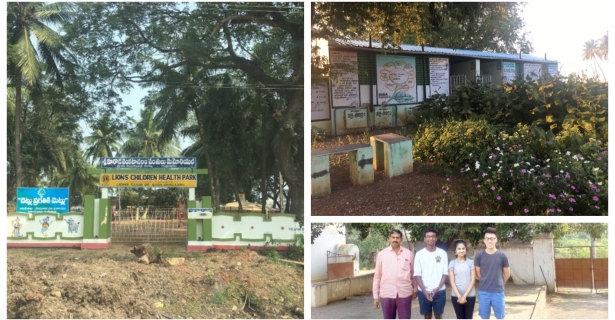As a member of Tufts International Development: India, I, along with two fellow students, Sachin Vallamkonda (A’21) and Mike Feng (A’21), travelled to India on a scouting and phase out trip. It consisted of an incredible amount of travel and research, but at every stop, we were afforded incredible kindness and were treated like family. We visited several communities and NGOs, such as Siliconandhra, Asha Sadan, Billapadu and Payir, our current partner NGO in Thottiyapatti.
One thing you have to understand is in India, word of mouth is sometimes the best way to find connections, and that’s exactly how we found Billapadu. Sachin’s neighbor’s uncle heard of the trip and connected us with a man named Ram Babu, whose family owns Billapadu. Our last day in Kuchipudi, the hospital manager, Ananya, arranged a rickshaw to get us the twenty kilometers to Billapadu. Ram Babu’s brother, very generously, let us stay in his farmhouse, which was one of the best accommodations of the trip, and the family provided food and bottled water for the two days we were there. Our first night was a little rocky, with Sachin and Mike spending a solid twenty minutes trying to, in vain, kill a spider, but the days after were far more educational and fruitful.
For a majority of the trip, we were scouting different NGO’s to find one to partner with, but in these two days, we were actually observing a model of ethical, sustainable development that started from the community up. We wanted a strong model in Andhra Pradesh to apply to whichever NGO we ended up partnering with, because while Payir is a fantastic model, it’s a model in Tamil Nadu, and we understood that different states required different strategies.
Our first day started early, at 8 AM, in a playground Ram Babu had commissioned as the local Lions chapter president. He then showed us the local government (public) school that subsisted on fundraising from the Lions club. At the school, the girls were given pads, and book fees and exam fees were covered by the Lions club. We also visited a milk pasteurizing facility that he was starting to ensure that villagers in the neighboring area could drink milk without fear of infection. At every place, we saw the first-hand impact of the Lions club’s projects, both from the students and from the townspeople themselves, and Ram Babu was very well acquainted with everyone we met.
That same day, we were taken to the multi-specialty hospital that the Lions club had set up and were given a tour of the optometry area. As we were walking around, he gave us a detailed account of the fifteen clinics that the Lions club had set up free of charge and was detailing the trials and tribulations that came along with being a Lions club chapter leader.
What really shocked me was how he had no need to do any of the work he was doing. At his age, he could easily simply manage his farmland and spend his days relaxing, but instead he feels such a strong urge to help the villagers. He spends an incredible number of hours ensuring that the livelihoods of the people are maintained. I think I speak for both Sachin and Mike when I say that that realization was humbling and truly forced us to look at our own development work through a new lens.
Our next day found us back at the school, where we were invited to watch a motivational speech about staying in school that the Lions club had organized. For a lot of the children, school is not a priority when they could easily drop out and work in the fields or domestically to help feed their families. In fact, some girls are doing domestic work after school as early as twelve, and the Lions club tries very hard to motivate the students to continue to study and get high marks on their tenth standard exams, as those exams could mean scholarships at a good university. Unfortunately, there’s only so much they can do when the culture normalizes children to leaving education early.
We found ourselves in Payir later on, ready to tie up loose ends, and were invited to speak with Senthil the day after we arrived. The meeting was only supposed to be half an hour long, as he had other business to attend to, but we spent almost an hour and a half speaking of the benefits of development and what our trip teams had gained from our time working with Payir. To him, our interaction with the people helped to expose them to a different culture and way of life, which he sees as beneficial.
As I was planning the trip, I had feared that we were veering in volunteerism territory, but his explanation repositioned how I viewed our involvement. As much as the people shape how we want to structure development, our visits can change how the people view the world outside their own microcosms.
Overall, we learned a lot during our visits with Billapadu and Payir. I am grateful for this experience and look forward to sharing it with those interested in international development.

